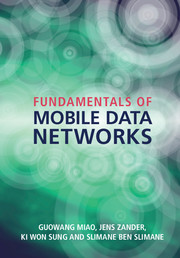Book contents
- Frontmatter
- Contents
- Preface
- Acronyms
- Notations
- 1 Introduction
- 2 Wireless network models
- 3 Medium access control
- 4 Scheduling
- 5 Principles of cellular systems
- 6 Transmitter power control
- 7 Interference management
- 8 Association and handover
- 9 Energy-efficient design
- 10 Long term evolution
- 11 Wireless infrastructure economics
- About the authors
- Index
- References
5 - Principles of cellular systems
Published online by Cambridge University Press: 05 March 2016
- Frontmatter
- Contents
- Preface
- Acronyms
- Notations
- 1 Introduction
- 2 Wireless network models
- 3 Medium access control
- 4 Scheduling
- 5 Principles of cellular systems
- 6 Transmitter power control
- 7 Interference management
- 8 Association and handover
- 9 Energy-efficient design
- 10 Long term evolution
- 11 Wireless infrastructure economics
- About the authors
- Index
- References
Summary
Introduction
In this chapter we take a closer look at the interference interaction between different radio communication links that share the same radio spectrum. As a first resource management scheme we consider static allocation when radio links are sharing the available bandwidth via proper orthogonal waveforms. The static allocation scheme is an excellent example to demonstrate most of the features and problems in resource management. It also serves as a reference for most more advanced schemes. Section 5.3 introduces a different resource management scheme to deal with interference in wireless networks. This resource management scheme, random channel allocation, is based on interference averaging by employing proper interference margins.
Orthogonal multiple access cellular systems
We start with a wireless network having a set of orthogonal waveforms. The design of wireless networks consists of two steps: coverage planning followed by frequency allocation.
Coverage planning
With signal power decreasing with the distance, it is easy to prove that the terminals should establish connections to the (geometrically) closest base station in order to maximize the received SINR. The service area may be partitioned into connection regions surrounding each base station. The connection region of a base station is the geometrical region where the received signal power from that base station is larger than that from any other base station and high enough to meet the quality requirements. Hence, the connection region is always included in the coverage area of the base station. The coverage area of each base station is referred to as a cell. The coverage planning problem is to find the required number of base stations to be used within the service area. For the sake of simplicity, assume that the terminals are located on a planar surface with a circular symmetric path loss. Requiring the same transmission quality in all coverage regions clearly means that these regions have to be of uniform shape and size. The most common model used for wireless networks is uniform hexagonal-shaped areas, called cells. Figure 5.1 shows the geometry of the (hypothetical) coverage regions of such a hexagonal cellular system. A base station with omni-directional antenna is positioned in the middle of each cell.
The area coverage planning is obtained by taking one cell as a reference and then computing the required cell radius such that the signal quality is satisfied over all the cell area.
- Type
- Chapter
- Information
- Fundamentals of Mobile Data Networks , pp. 95 - 145Publisher: Cambridge University PressPrint publication year: 2016



